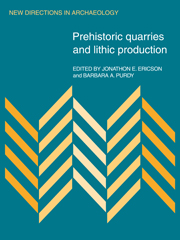Book contents
- Frontmatter
- Contents
- List of contributors
- Dedication
- Part 1 Introduction
- Part 2 Procurement, production, and exchange
- 2 Mount Jasper: a direct-access lithic source area in the White Mountains of New Hampshire
- 3 Procurement without quarry production: examples from southwestern Idaho
- 4 The 63-kilometer fit
- 5 Monopoly or direct access? Industrial organization at the Melos obsidian quarries
- 6 Lithic material demand and quarry production
- 7 Economic aspects of prehistoric quarry use: a case study in the American southwest
- 8 Preliminary report on the obsidian mines at Pico de Orizaba, Veracruz
- 9 State-controlled procurement and the obsidian workshops of Teotihuacán, Mexico
- Part 3 Technology and techniques
- Index
4 - The 63-kilometer fit
Published online by Cambridge University Press: 04 August 2010
- Frontmatter
- Contents
- List of contributors
- Dedication
- Part 1 Introduction
- Part 2 Procurement, production, and exchange
- 2 Mount Jasper: a direct-access lithic source area in the White Mountains of New Hampshire
- 3 Procurement without quarry production: examples from southwestern Idaho
- 4 The 63-kilometer fit
- 5 Monopoly or direct access? Industrial organization at the Melos obsidian quarries
- 6 Lithic material demand and quarry production
- 7 Economic aspects of prehistoric quarry use: a case study in the American southwest
- 8 Preliminary report on the obsidian mines at Pico de Orizaba, Veracruz
- 9 State-controlled procurement and the obsidian workshops of Teotihuacán, Mexico
- Part 3 Technology and techniques
- Index
Summary
A number of simple geoarchaeological techniques were used to study the distribution of prehistoric populations and to reconstruct behavior patterns at sites in the Colorado Desert region of southern California. Samples from two quarry-workshop sites, RIV-1814 and RIV-1819, at opposite ends of Chuckwalla Valley, were systematically collected and micromapped, and knapping technology was reconstructed. Distribution patterns for the artifact forms and materials from these quarry workshops were determined by examining samples from other sites within and adjacent to Chuckwalla Valley. Hypotheses regarding the long duration of site utilization and late prehistoric/protohistoric occupation by Numic peoples were verified. Artifact production analysis, including refitting of flakes and cores, proved highly successful. One set of flakes from RIV-1819 near the Colorado River was refitted with a core from an occupation site 63 kilometers away, at the opposite end of the valley. Prehistoric quarry workshop sites are viewed as an underexplored resource with great potential for yielding important data on technology and population demography.
Introduction
Prehistoric quarry workshops were an important early focal point in American archaeology (e.g., Holmes 1919) and such sites are once again beginning to attract the attention of archaeologists concerned with the reconstruction of extinct cultural systems. Today's trend toward technological, functional, and behavioral lithic analyses is well grounded in past research (e.g., Holmes 1894) but owes much of its current foundation to the pioneering work of scholars such as S. A. Semenov (1964) in the U.S.S.R., F. Bordes and others in France, and Don Crabtree and his many students in the U.S. But, for the most part, quarry workshops remain understudied, probably because of the variety of problems they seem to present.
- Type
- Chapter
- Information
- Prehistoric Quarries and Lithic Production , pp. 35 - 48Publisher: Cambridge University PressPrint publication year: 1984
- 8
- Cited by



